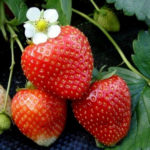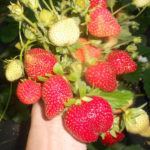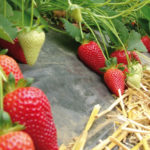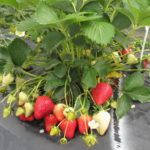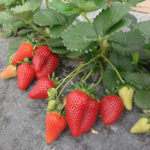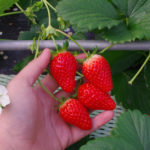Grape variety Timur
The hybrid form of Timur table grapes was obtained at the All-Russian Research Institute of Viticulture and Winemaking named after V.I. Ya. I. Potapenko by a team of scientists led by the famous Russian breeder, Honored Agronomist of the Russian Federation Ivan Kostrikin.
The new hybrid was born into a large "Vostorg family". Famous varieties became his parents: Frumoasa Albă of Moldavian selection, and perhaps the most famous native of the Novocherkassk Institute - Delight... Among the offspring of this pair, the researchers identified, in addition to our hero, several more hybrid forms, including such popular ones as Mascot, Tamerlane, Elegant and Muscat Delight. Timur, in turn, also managed to participate as a paternal form in the development of new hybrids (Millennium, Timur pink, Jubilee of the Kherson "Dachnik", Sphinx, Ramzai, etc.).

The characteristics of the new hybrid were greatly influenced not only by the parents, but also by more distant ancestors, among whom you can find a complex cocktail of representatives of the European-Asian, Amur and American grapes. In all this diversity, the genes of the cultivated species Vitis vinifera are responsible for the high quality of the fruits, and first of all the wonderful Central Asian varieties of Katta Kurgan and Guzal kara, which take their place in the pedigree of our hero on the maternal side. The Amur and American species determined the cultivar's good resistance to fungal diseases and frost. However, this advantage also has a reverse side of the coin. The Amur ancestor "rewarded" his descendant with a demand for sufficient air and soil moisture. With a lack of water, Timur develops very depressed: the strength of growth decreases, the size of the bunches and the yield in general decreases, in a dry climate there are problems with pollination, the berries are very pea.
For the sake of completeness, the advantages of the variety include the early ripening period and high "Vostorgskoe" sugar accumulation, and among the disadvantages - the weak transportability of the bunches. The grapes are not firmly attached to the bunch, which is why they easily crumble even with a weak mechanical load.
Such inconsistency and instability did not allow the hybrid to claim a place in the state register of breeding achievements admitted for industrial use. However, among fans, although he causes heated debates, accompanied by both exclamations of admiration and disappointment, he nevertheless continues to be in demand, and even has a circle of loyal fans who categorically declare that they will never give up on him. It is quite possible that the lack of unanimity lies in the diversity of the climate of the places where it grows, and in suitable conditions, Timur is devoid of those shortcomings for which ill-wishers criticize him.

Agrobiological characteristics
Grape bushes are weak and medium-sized, are not distinguished by the highest vital energy, and therefore the close proximity and competition with more vigorous varieties often do not withstand. The crown of a young shoot is of a semi-open type, yellowish-green, with white tomentose pubescence. The leaf is large, five-lobed, elongated, moderately dissected, saturated green, with a reticulate-wrinkled surface. The upper side cutouts are of medium depth, open, slit-like, or closed with a narrow elliptical opening. The bottom notches are often missing or barely outlined. The petiole notch is open, lyre-shaped with a sharp bottom, or closed with an elliptical lumen. Petioles are long, light green. The lateral teeth of the leaf are medium in size, dome-shaped. The flowers are bisexual, but this is not a guarantee of their successful pollination. Grape growers often complain about significant peas in the berries. The vine ripens very well.The vegetative shoots of Timur are greenish-white; when ripe they change color to yellowish-brown or darker.
Bunches of grapes are not very large, conical or cylindro-conical, of moderate density or somewhat loose, with an average weight of 400-700 grams. The stem of the crest is long, well developed, branched, light green in color. The attachment of grapes to the cluster is weak. The berries of the variety are large, 29 mm long and 21 mm in diameter (the maximum reaches 42 × 23 mm), elongated with a pointed tip, or nipple-shaped, with an average weight of 6-8 grams. The color depends on the lighting of the bunches during the ripening period, and, depending on this, changes from greenish to almost white, with an amber or slightly brownish tan on the sunny side. Timur's pulp is yellowish-green, dense, crispy, harmonious, with some astringency in the taste and a slight nutmeg tint in the aroma, which appears after full ripening. The juice squeezed from berries contains up to 22 grams / 100 ml of sugars, and about 6-8 grams / liter of titratable acids. The skin is thin and fragile, covered with a faint pruin bloom of light color, it is weakly felt when eating. Standard grapes contain 2-3 seeds, while peeled grapes are often seedless.

The grapes are consumed fresh. With normal pollination and sufficient illumination during the ripening period, the bunches of this variety acquire an excellent presentation, pleasing the eye of the grower and being in good demand on the market. Despite the rapid accumulation of sugar, you should not rush to harvest the crop. When fully ripe, its gastronomic qualities noticeably improve: the tart-herbaceous aftertaste disappears, the pulp becomes noticeably sweeter, the aroma shows nutmeg notes, and the skin acquires an elegant tan. This is exactly what the ideal Timur should be. For transportation over long distances, as already mentioned, grapes are not suitable. It tolerates storage better, but here it is not worth relying on for long periods, because of the not very strong skin of the berries.
Removable maturity in the variety begins early - 105-115 days after the start of the growing season. To do this, he needs to obtain 2200-2400 ° C of the sum of active temperatures. This allows, when taking measures to shelter plants for the winter, without any problems cultivating it even in the conditions of the Moscow region, to which there is a mass of evidence of amateur winegrowers. When picking early, it is necessary to take into account the peculiarity of this grape variety, which consists in the uneven ripening of the bunches on the bush. Therefore, harvesting should be carried out selectively, after a preliminary assessment of the degree of ripeness of each particular brush.
The potential yield of the hybrid is very high. In non-sheltering culture, Timur has a significant proportion of fruitful shoots - 70-80%. The number of clusters per fruitful shoot approaches two. Even shoots that have developed from dormant and replacement buds have the ability to lay inflorescences, and on stepchildren, taking into account the early maturity of the variety, you can get a second harvest per season. Thus, it is problematic to remain without a crop in Timur's case, because even late spring frosts do not deprive the chances of a harvest. At the same time, this specificity imposes on the grower the responsibility for rationing the bushes with the harvest, due to their tendency to overload. The calculation should be based on the plant's ability to produce about 15 kilograms of grapes without harming itself due to too abundant fruiting.
After ripening, the crop can continue to hang on the bushes, provided that the bunches are protected from wasps. Insects easily damage sweet berries with a thin skin, because of which they deteriorate and lose their presentation. The problem can be fundamentally solved by placing the brushes in special individual bags, where they will become inaccessible to annoying pests. Timur does not show strong cracking of berries, however, a sharp drop in soil moisture or a long rainy period during ripening can lead to this kind of damage to the crop. Intense heat, on the contrary, can cause overripe grapes to wilt right on the bush.
Agrotechnical features
The cultivation of this variety of grapes is associated both with an element of luck, in terms of favorable climate and specific weather conditions for obtaining a good harvest, and with meticulous systematic work of the grower to ensure optimal plant care. This characterizes the variety as demanding and insufficiently plastic, but with all this, it cannot be called capricious and pampered.
For growth, Timur prefers warm, moisture-rich soils of light and medium texture. When cultivated on heavy soil, the taste of the fruit deteriorates, and in arid conditions the plants themselves develop depressed, they have problems with both growth and productivity. Particularly critical periods with regard to moisture availability are the periods before the flowering of the grapes and during the growth of the berries.
The variety propagates easily both in its own rooted culture and in a grafted one: its cuttings root well, and as a scion they show good affinity with common rootstock forms. At the same time, it is still desirable to plant seedlings grafted on vigorous rootstocks, the best of which is Berlandieri x Riparia Kober 5BB. This has a positive effect on the growth force of the bush itself and on its yield, although it somewhat postpones the timing of harvesting and the entry into fruiting in comparison with self-rooted plants. When planting grapes with rooted cuttings, the first "signal" brushes on the bushes can be obtained already in the second year, while the grafted seedlings lag behind in development by an average of a year.
The increased frost resistance of Timur (-25 ° C) makes it possible to grow it in an open culture on a high stem in most traditional wine-growing regions. It allows the formation of powerful bushes with a large supply of perennial wood, which significantly increases the mass of bunches, and, ultimately, the overall yield of the variety. Where resistance to low winter temperatures is insufficient due to the severity of the climate, one has to be content with standard covering schemes, and, as a result, medium-sized fruits. There are, and in some regions can be applied, intermediate semi-covering options, when the main part of the grape bush is formed on a trunk, and an additional lightweight layer is covered, acting as a reserve in case of the death of the uncovered part.
Plants that have entered fruiting need careful regulation of the load of shoots and crops. The number of eyes left after spring pruning may differ depending on the growth strength of a particular bush, but usually ranges from 25 to 40 pieces. The trim length can be either long or short, and depends primarily on the selected shaping. In standard schemes with powerful cordons and a significant number of fruit links, a strong shortening of the arrows is advisable, while in the case of a covering multi-arm fan, a long pruning is better. After the beginning of the growing season, the variety will need a fragment of weak and sterile shoots, additional pollination of grape inflorescences with puffs, thinning of the brushes with the removal of excess ones, as well as lightening of the bunches during their ripening. In the process, 20-24 shoots are left on the bushes, on which all the brushes, except for the largest ones, are subsequently removed, no more than one per shoot. Only on strong vines, as an exception, can two bunches be kept. In total, an average of 28-32 bunches should go out per bush.
Timur's strong point is his resistance to a number of fungal diseases. So, the variety is almost not damaged by gray rot, it has increased resistance to mildew and powdery mildew. This determines the strategy of treating grapes with plant protection products - 1-2 preventive treatments will be enough against powdery and downy mildew.Good results are also shown by ensuring aeration of the bush, and especially its fruit zone. Rapid drying of leaves, shoots and bunches after rains and morning dew will significantly reduce the harmfulness of pathogens.
So, our hero should be recognized, although a controversial hybrid, but, nevertheless, worthy for growing on a personal plot. It may not be worth planting many shrubs at once, limiting yourself to one or two to take a closer look at the variety, its ability to grow and bear fruit consistently in your climate. In case of successful completion of a personal variety test, you can safely enroll in the army of admirers of this grape, since over the years, increasing the perennial wood, Timur will only get better and better.
